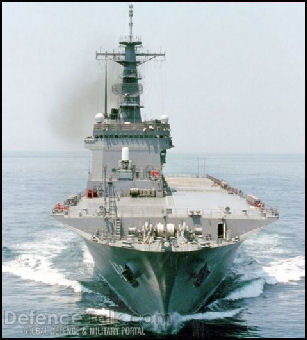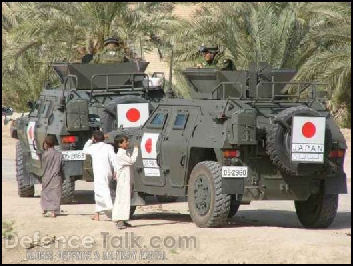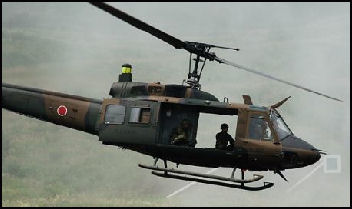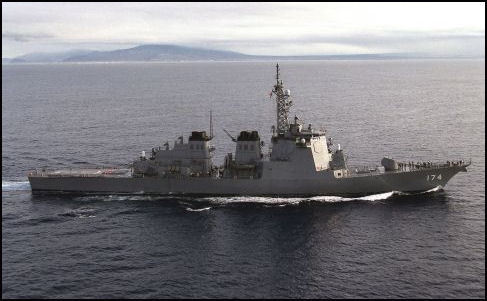JAPANESE MILITARY PRESENCE ABROAD

The American-written Japanese constitution prevents Japan from creating a military force "able to project power beyond its own shores." Japan's military did not take part in the first Persian Gulf War in 1991, but the government contributed $13 billion dollars of $61 billion needed to finance the war and sent some minesweepers but no troops. The Japanese constitution is one reason it didn't participate military.
In November 2001, Japan sent military ships to the Arabian Sea to support the American offensive against terrorism in Afghanistan. See Refueling Missions Below
The Japanese military also sent ships to Aceh, Indonesia after the tsunami in 2004 in what was that country’s largest overseas military operation since World War II. The Japanese sent three ships — a destroyer, an amphibious ship and a supply vessel — and two hovercrafts loaded with trucks and medical equipment and 970 military personnel. The ships arrived in mid January. Their primary goal was to provide medical service and prevent epidemics.
Japan, India and the United States have participated in joint naval drills in the Pacific Ocean. The exercises have been widely viewed as a means of strengthening military ties between the three nations and to show they were a united front against China. In May 2007, Japan,, the United States, Australia and Singapore participated in joint naval exercises in the Bay of Bengal.
Japanese Peacekeepers and Related Activities
Japan sent peacekeeping troops to Cambodia in 1992 (the first overseas mission for Japanese troops since World War II), and later Rwanda and the Golan Heights in Israel. Japan didn't send peacekeeping troops to East Timor even though Australia and the United States encouraged it to. Lee Kuan Yew once aid that allowing Japan to send peacekeeping troops abroad would be "like giving chocolate liqueur to an alcoholic."
In Cambodia, two Japanese civilians were killed in 1993. One was a United Nations election monitor. He was shot dead. The other was a policeman who was killed when he and for other Japanese policemen who were ambushed by armed guerillas.
The SDF sent peacekeepers to Nepal as part of an international mission there. A 350-member SDF unit of engineers and peacekeepers was dispatched to Haiti after the earthquake there in February 2010. Most of the unit was made up of engineers involved in reconstruction. This mission involved peacekeepers carrying rifles, handguns and machine guns to defend themselves.
In August 2010, the Japanese government said it would help out in the Afghan war effort by training Afghan police in Turkey. In August 2010, Japan sent six helicopters and 210 Ground Self-Defense Force personnel to Pakistan to help in flood relief there. The Japanese government is considering sending SDF troops to Darfur.
Japan Sends Peacekeepers to South Sudan
In November 2011, the Yomiuri Shimbun reported, the Japanese government officially decided to dispatch a Ground Self-Defense Force engineering unit to South Sudan for U.N. peacekeeping operations. About 300 GSDF personnel were be sent to the country. Based in Juba, the country's capital, the GSDF unit is responsible for repairing roads, airports and other damaged infrastructure under the U.N. Mission in the Republic of South Sudan. [Source: Yomiuri Shimbun, November 2, 2011]
After the first group of Japanese peacekeepers arrived in South Sudan, Tetsuya Mizuno wrote in the Yomiuri Shimbun: “The central African country, which became independent in 2011 after more than 20 years of civil war, has high expectations of the SDF's civil engineering skills. Facing sandy dust and fierce sunlight — which often pushes temperatures to more than 40 C — members of the about 120-member main unit inspected a main road in Juba. inspected a section of the road near the White Nile, which runs through the capital and plays an important role in the distribution of goods in the landlocked country.They found many depressions dozens of centimeters deep, preventing all but high-bodied four-wheel-drive vehicles from using the road. "I didn't expect the road to be in such bad condition," said Maj. Norihisa Urakami, 46. "This is also a route to the city center, so improving the road could have huge benefits." [Source: Tetsuya Mizuno , Yomiuri Shimbun, February 24, 2011]
The Japan International Cooperation Agency plans to build a new bridge over the river about two kilometers south of the inspection site, using official development assistance from the Japanese government. The SDF sees the road as a possible site for its peacekeeping activities in the capital, as it is linked to the planned bridge, thus making an "all-Japan" contribution to South Sudan. The sdf unit is also studying the possibility of working near a river port in Juba that JICA plans to expand. The SDF dispatched its first batch of about 200 personnel in January 2012. They have been making inspections throughout the capital while building a camp for the mission. Road improvement work is scheduled to begin around April.
South Sudan is 1.7 times the size of Japan but has only 60 kilometers of paved road. It could not afford to develop roads or water systems due to the prolonged civil war. Atsushi Hanatani, head of JICA's South Sudan office, said the new country has "unlimited" need for infrastructure development. "If we can get help from the sdf, I believe our projects will be more effective," Hanatani said as he accompanied the SDF members on the inspection. One reason for making "all-Japan" efforts to contribute to South Sudan is that it is one of the world's leading countries in terms of oil reserves.
Juba is several hundred kilometers away from the conflicts in South Sudan's northeast and on its border. The capital has relatively few security problems. In the northern city of Malakal, where Indian troops have been working, the security situation is unstable and there are many ordinary crimes as well. In the western city of Wau, where Chinese troops set up their headquarters, the security situation is worse than Juba. Japan insisted on limiting GSDF activities to Juba because it is afraid GSDF members might become involved in fighting and forced to use weapons if they are stationed in areas with poor security. Under current standards that allow sdf personnel to use weapons for self-defense purposes or in an emergency situation, SDF members cannot defend other countries' units even if they are attacked by armed insurgents. A senior sdf officer dispatched to South Sudan said, "In dangerous areas, we'd be more likely to encounter situations that would involve these standards.”
Japanese Peacekeepers in Haiti
The government sent GSDF members to Haiti to participate in a mission to rebuild the earthquake-hit country in February 2010. In December 2012 they returned home. On that mission Masakazu Hamasuna wrote in the Yomiuri Shimbun: “A Ground Self-Defense Force rescue team has ended its participation in a U.N. peacekeeping operation in Haiti that lasted two years and 10 months. "We've completed our duties, swiftly and flexibly responding to complicated and diverse needs. Now, let's take pride in our work and return home with dignity," said Ryu Kanno, the head of the unit, giving his last words as the team's leader. [Source: Masakazu Hamasuna, Yomiuri Shimbun, December 27, 2012]
The rescue team was dispatched to Haiti after a massive earthquake struck the country in January that year, killing about 320,000 people. About 2,200 SDF members took part in more than 200 types of work, including debris removal and road repair. They were highly praised for their efforts by the Haitian government and the United Nations.
Japan Ends Its 17-Year Peacekeeping Mission in the Golan Heights
In December 2012, Japan ended its peacekeeping mission in the Golan Heights due to security concerns in war-torn Syria. Jiji Press reported: “A 33-strong contingent of the Self-Defense Forces returned from its peacekeeping mission on the Golan Heights in southwestern Syria, effectively putting an end to 17 years of Japanese participation in the U.N. Disengagement Observer Force. On December 21, then-Defense Minister Satoshi Morimoto ordered the SDF to end the mission in the troubled region because security there was rapidly deteriorating. [Source: Jiji Press, January 1, 2013]
"I feel relieved because we all came back to Japan safely," said Ground Self-Defense Force Capt. Masaki Umetani, 33, executive officer of the contingent. "We are proud because we have played a role in the 17-year peacekeeping mission on the Golan Heights." The Golan Heights mission, based on the law for cooperating in U.N.-sponsored peacekeeping operations abroad, began in February 1996.
With Japanese peacekeepers taken out of the Golan Heights and Haiti, South Sudan is the only place where SDF elements are still participating in a U.N. peacekeeping operation. Although there are some concerns that Japan's international peace contribution may stagnate, Namatame said, "I believe the Japanese unit will be highly acclaimed if we continue what we've been doing for one year for another six months, another year, or longer.”
Japanese Troops in Iraq

Japan in Iraq In January 2004, members of the Japanese Self Defense Force arrived in Iraq with much fanfare. A total of 1,000 non-combatant troops (including 550 Ground Self-Defense Force personnel and 450 or so Maritime Self-Defense Force and Air Self-Defense Force personnel) were deployed. The Maritime Self-Defense Force and Air Self-Defense Force personnel were mostly involved in transporting ground troops and military hardware and supplies to Iraq.
The 550 Ground Self-Defense Force personnel were deployed in Samawah, near Nassiriya, in a place where there was relatively little military activity, and spent most of their time in a camp surrounded by an 800-meter-wide perimeter, regarded as adequate to thwart any attack. They were involved in projects like water purification and providing medical services and improving schools and other public facilities.
The Japanese base in Iraq had a large recreation facility with video and audio machines, a gym, and a library with Japanese newspapers and magazines. For safety reasons the troops rarely left the camp and when they did they were given a military escort. Out of respect to local Islamic customs the soldiers didn’t drink alcohol or eat pork and studied Islam before they left Japan.
The Japanese troops were initially welcomed enthusiastically with open arms because it was thought they were going to bring jobs but when that turned out not to be the case some Iraqis were hostile towards them. Occasionally rockets and mortars were fired at the camp. As time wet on Samawah became more and dangerous and Japanese troops gave up on their development projects and stayed in their camp, in some cases protected by British and Dutch soldiers.
Japan also pledged billions in aid and loans to Iraq and promised to forgave some of the debts that Iraq owed. Japanese Prime Minister Shinzo Abe met with Iraqi Prime Minister Maliki in April 2007 and pledged to support Iraq’s reconstruction.
Justification for Japanese Troops in Iraq
In July 2003, the Japanese parliament passed a law that allowed the SDF to send troops to Iraq. In accordance with the anti-war constitution the troops were allowed on condition they followed strict guidelines and didn’t engage in warlike activities. Polls indicated that less than half of Japanese supported sending troops to Iraq. Al-Qaida threatened to attack Tokyo if Japan sent troops to Iraq.
In December 2004, Koizumi decided to extend the mission of the Japanese troops in Iraq for one year. The first mission expired December 14, 2004. The mission was extended again.
In July 2006, Japan withdrew the last if its troops from Iraq. The pullout was announced a month earlier. The Japanese government said the decision was based on the belief that the timing was right for security duties to be taken over by local Iraqi authorities.
After that Air SDF troops were stationed in Kuwait. None were in Iraq. The forces are mainly involved in air-lifting supplies using blue C-130 cargo planes between Kuwait and Iraq. In July 2007, the Japanese mission to air lift supplies to Iraq was extended for two years until July 2009.
In December 2008, the air-lift missions were ended, bringing to a close Japan’s four year involvement in Iraq. In April 2008, a high court in Japan ruled that the Air Self-Defense Force plan to airlift armed troops from the multinational forces in Bagdad was illegal as it violated the war-renouncing Article 9 of the Japanese Constitution. Japan has continued to technological and economic aid to Iraq.
Japan formally ended its stay in Iraq in February 2009.
Changes in the Japanese Military to Address Its Missions Abroad

After the terrorist attack on the World Trade Center in New York on September 11, 2001, the Antiterrorism Law was passed in Japan that allowed the government to dispatch SDF personal overseas to provide support in military campaigns against terrorism. This revision of the Peace Constitution allowed Japan to move away from what has been called the "hedgehog defense." Ironically the United States — the author of the Peace Constitution — was main foreign supporter of a stronger Japanese military.
Prime Minister Koizumi called for the creation of a national security council modeled after a similar body in the United States and argued for changing the emphasis of the Japanese military from being strictly defensive to being more offensive and allowing military support in “noncombat areas” in international conflicts.
In 2001, Japanese ships were sent to the Indian Ocean to support the American campaign in Afghanistan. In 2003, Japan sent an Aegis destroyer to the Persian Gulf to support American forces there and sent troops to Iraq.
In June 2003, parliament passed three laws that expanded the power of the military and allowed it to work more closely with U.S. military forces, especially in Iraq.
A law to upgrade the Defense Agency to ministry status was passed in parliament in December 2006. The Defense Ministry was inaugurated in January 2007. The move was largely symbolic, widely seen as a measure to address threats presented by China and North Korea and described by the Japanese government as a step to become a “normal country.” The Defense Agency was an administrative organ affiliated with other bodies. As a ministry it would take on defense duties directly that were previously were listed as peacekeeping duties and raise issues on it own rather than getting permission within the cabinet first to raise issues.
Japanese Refueling Missions
In accordance with the 2001 anti-terrorism law, Maritime Self-Defense Force refueling ships have assisted the United States and coalition missions in Afghanistan by refueling ships bound for the region in the Indian Ocean.
The refueling missions have largely been symbolic but with American losing support from other nations around the world having support from Japan has been important for the United States. The Japanese public had little interest in the issue which became a matter of face for Japanese politicians involved.

Kongu class destroyer
The refueling missions began in December 2001 as the United States was preparing to wage war against Al-Qaida and the Taliban in Afghanistan. Between 2001 and 2007, Japan supplied 490,000 kiloliters of fuel, worth about $190 million on 794 occasions to vessels from 11 countries, including France, Britain, the United States and Pakistan.
In October 2007, a Maritime Self-Defense Force refueling ship performed its last refueling missions before the law that sanctioned it expired. In November the refueling ship returned home from Indian Ocean, formally ending Japan’s almost six years logistical support of U.S. antiterrorism operation,
A political struggle took place over whether the missions should be resumed. The LDP was keen on resuming the mission in part o show the world that Japan was playing an important military role on the world stage. The opposition Democratic Party opposed the missions, saying the U.S. invasion of Afghanistan was not sanctioned by the United Nations and that some of fuel ended up on ships heading for Iraq, violations of Japan’s peace constitution.
Th issue cost Prime Minister Abe his job and caused Prime Minister Fukuda to lose face. U.S. Defense Secretary Robert Gates entered the fray, saying that Japan needed to accept its global role and responsibility if for no other reason than the fact that Japan benefits from global stability.
In January 2008, the Diet passed an anti-terror bill, which included approval to resuming the of he refueling missions in the Indian Ocean. The bill passed the lower house but was rejected 133-106 by the upper house but then was approved with a 340-133 vote, exceeding the th necessary two thirds majority, in the LDP-controlled lower house. The MSDF resumed refueling missions in the Indian Ocean February 2008.
There was some discussion of providing logistical support in Afghanistan itself but many in Japan felt those missions would be too dangerous.
The Hatoyama government ended the refueling missions in the Indian Ocean that supported the war in Afghanistan in January 2010. Earlier it pledged to help in Afghanistan and Pakistan by giving the country $5 billion in aid over five years, with much of the money going to beefing up Afghanistan’s security and much of the rest going to infrastructure projects. In the end the termination of the refueling missions came at a time when they were not that necessary as much of the war effort in Afghanistan relied on air transport. There was some discussion that China might take over the refueling missions.
The Hatoyama government has also talked stopping the participation of Japan in international efforts to combat piracy off Somalia.
Anti-Piracy Mission in Somalia
In March 2009 two Japanese destroyers — with a 400-man crew, including a special unit trained to board ships — and helicopters were sent the Gulf of Aden on a four month mission to aid in the fight against pirates from Somalia. Their primary mission was guarding ships with ties to Japan as they navigated a 1,000-kilometer-long stretch of sea off the coast of Yemen and helping foreign ships that are in trouble.
Sending the ships was matter of debate. According to some certain aspects of the mission violated the Peace Constitution. A bill had to be passed by the Diet before the ships were allowed to go. Under the terms of bill the ships were only allowed to use their weapons in self defense if attacked by pirate boats. One survey in Japan found that 60 percent of Japanese supported the anti-piracy mission
The ships protected by the Japanese traveled in convoys watched over by the destroyers and had to apply in advance to be protected . Ships that needed emergency help but had not received permission in advance to be protected had to go thorough a bureaucratic process to get approval before the destroyers could help them.
An antipiracy law passed in the Diet in June 2009 authorised Japanese vessels to protects ships with no connection to Japan.
In July 2010, the Japanese government said that it was considering refueling vessels involved in anti-pirate activities off of Somalia. In May 2011, the Yomiuri Shimbun reported, “The Self-Defense Forces opened its first full-fledged overseas base” a facility in Djibouti that will enable the SDF to beef up an antipiracy mission off Somalia that could continue for years. The government plans to have the facility in northeastern Africa serve as a major base for future international contributions by the SDF in the Middle East and Africa, government officials said.” [Source: Yomiuri Shimbun, May 29, 2011]
“The facility will be the first de facto overseas base for stationing SDF personnel abroad. About 150 members of the Maritime Self-Defense and Ground Self-Defense forces, plus reinforcements of about 20 personnel, will be stationed at the base. The region around Djibouti has been a key arena in U.S. antiterrorism operations, so the SDF installation is expected to strengthen the bilateral Japan-U.S. alliance. A U.S. base is nearby.”
“Facing the Gulf of Aden next to Somalia, Djibouti is about 10,000 kilometers from Japan. Its strategic location made it an ideal choice to set up a base from which to conduct patrols and surveillance against pirates in the region. The base will serve as a relay point for SDF supplies and personnel, reducing the need to send transport aircraft whenever SDF personnel are dispatched on missions abroad, they said.”
Image Sources: Defence Talk
Text Sources: New York Times, Washington Post, Los Angeles Times, Daily Yomiuri, Times of London, Japan National Tourist Organization (JNTO), National Geographic, The New Yorker, Time, Newsweek, Reuters, AP, Lonely Planet Guides, Compton’s Encyclopedia and various books and other publications.
Last updated January 2013
